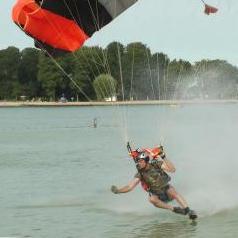Recommended Posts
skydivecatI apologize for not being more clear in my reply. I did not mean to imply it had never been done or never could be done, more that it was not a usual method of student learning that is commonly offered as training anywhere I have seen/jumped. If that is something you do at your dz, then I learned something new.
If someone wanting to do a iad/aff student jump is focused on the ability of the instructor being able to fly to them/help/save them, I believe they need to re-evaluate jumping as an iad or aff student and stick to a tandem or not jumping.
No apology necessary, I believe we are the only ones to ever do it and you would have no way of knowing about it.
obelixtim 100
Baksteen***That was a crap effort whoever determined the spot.....but the 3 kms illustrates my point perfectly.
Boy, was it ever...
I'm not disagreeing with you though; 3.5Kft is the best exit altitude for SL.
Did anyone actually know how to calculate the exit point for a high altitude opening/cross country jump?
It takes a little bit more than guess work....
I would have let them walk home....
yoink 321
Or is there something more sophisticated?
obelixtim 100
yoinkDrop a WiDI and extrapolate from there?
Or is there something more sophisticated?
Yep. Like any unusual jump, planning is required if you want to be successful.
A: From ATC obtain a list of wind velocities and bearings for every 1000 feet of altitude to your planned exit altitude. You'd be surprised by the sometimes quite wide variations in wind speeds and headings at different levels.
B: On a map plot the mean wind direction, using the bearings given from ATC for every 1000 feet.
C: For every 30 knots of wind, allow 1 mile of ground travel per 1000 feet, upwind of the DZ. (With a tailwind + canopy speed you should travel 1 mile) and work out your average wind speed from exit altitude to ground level.
D: On your map you can now calculate your exit point upwind from the DZ. So you should allow 1 minute of canopy flight per 1000 feet, and 1 mile of travel per minute if you have an average wind speed of 30 knots.
Its not difficult. I've done quite a few cross countries from 12 grand, and travelled 12 miles or more, to land back at the DZ. Never missed once.
A couple of other considerations to think about:
Have a chase vehicle under the exit point, to follow the load home, and to pick up off landers/lost gear/injuries.
The load(if more than 1 jumper), need to stay together for the whole flight.
Carry phones.
Land near a road if landing off, for ease of pick up.
Have a plan if someone has a mal and has to chop, and someone has to follow the jumper down and watch the cutaway gear and freebag, and to land with the reserve rider. (It is NOT a good idea to ride a malfunction down to lower levels in order to retrieve cutaway gear)
Have the jump pilot verify all jumpers have opened OK after exit, and communicate information to the ground crew.
Plan your jump, and JUMP YOUR PLAN. If conditions change, make a new plan, don't stick to the old one.
Include everyone in your briefing, jumpers, pilot, ground crew, chase crew.
Advise ATC and your local police, in case any whuffos report plane crashes with bail outs (this does happen and the cops won't go off on wild goose chases, if a simple phone call has alerted them of your intentions)
So there.....
wolfriverjoe 1,339
"~ya don't GET old by being weak & stupid!" - Airtwardo
obelixtim 100
wolfriverjoeWhere 'from ATC' does one get a wind report for winds aloft every 1000'?
They should have access to met data, which is usually updated at 4 hourly intervals. They pass local information to pilots.
Get your pilot to ask the tower jocks where he can access updated local weather information.
We do it on the phone....
wolfriverjoeWhere 'from ATC' does one get a wind report for winds aloft every 1000'?
This is the best place for winds:
https://markschulze.net/winds/
Cloggy 1
Until now I used the local aviation weather bulletins (Belgium and the Netherlands), these are usually updated two or three times per day.
I throw the numbers from the bulletins in an Excel spreadsheet. Together with the opening altitude, minimum altitude over target, descent rate and canopy forward speed it calculates an exit point. Per vertical interval I calculate the drift, sum all these vectors and take the forward speed of the canopy itself into account to get bearing and distance of the exit point.
(Unfortunately the spreadsheet is not in a state that I can share, I threw it together in a hurry and it needs refinement.)
evh 22
obelixtim
A: From ATC obtain a list of wind velocities and bearings for every 1000 feet of altitude to your planned exit altitude. You'd be surprised by the sometimes quite wide variations in wind speeds and headings at different levels.
B: On a map plot the mean wind direction, using the bearings given from ATC for every 1000 feet.
C: For every 30 knots of wind, allow 1 mile of ground travel per 1000 feet, upwind of the DZ. (With a tailwind + canopy speed you should travel 1 mile) and work out your average wind speed from exit altitude to ground level.
D: On your map you can now calculate your exit point upwind from the DZ. So you should allow 1 minute of canopy flight per 1000 feet, and 1 mile of travel per minute if you have an average wind speed of 30 knots...
I think this was the plan. One big misstake was made: the weather data was incorrect.
During the day the winds were pretty strong, these values were used to calculate the exit point. But we jumped just before sunset, when the winds became almost zero





I apologize for not being more clear in my reply. I did not mean to imply it had never been done or never could be done, more that it was not a usual method of student learning that is commonly offered as training anywhere I have seen/jumped. If that is something you do at your dz, then I learned something new.
If someone wanting to do a iad/aff student jump is focused on the ability of the instructor being able to fly to them/help/save them, I believe they need to re-evaluate jumping as an iad or aff student and stick to a tandem or not jumping.
Share this post
Link to post
Share on other sites